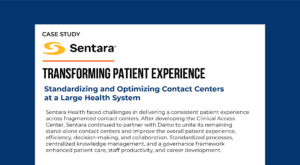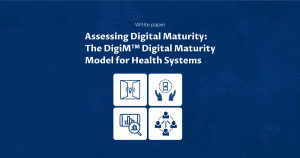Healthcare digital transformation: 5 predictions for 2021

When I published my year-end forecasts last year, I started with this: Short of a “black swan” event, 2020 will see a slow but steady advance in healthcare’s digital transformation. As it turns out, I was indirectly predicting the mother of all Black Swan events, namely the pandemic.
The pandemic has created what could be the next trillion-dollar opportunity – telehealth.
Based on my firm’s work and research, we have seen 50x or more increases in telehealth visits across the board. During the months following the pandemic, we saw healthcare enterprises increase their focus on enhancing online experiences through digital front door tools.
Perhaps the most important outcome of the pandemic has been its impact as a great equalizer. The market now favors “digital-first” companies, i.e., those who deliver healthcare primarily as online experiences, especially for ambulatory and low-acuity care needs.
Against a backdrop of rapid virtualization of healthcare, here are my five predictions for 2021:
- Telehealth technologies will mature to address specific patient and caregiver needs: In the immediate wake of the pandemic, every health system had to implement or rapidly scale a telehealth program. Health systems have taken a cookie-cutter approach to telehealth, often involving sub-optimal technology tools strung together in a loosely integrated architecture. Digital leaders are now looking beyond COVID-19 to redefine their telehealth programs for the longer term. Telehealth platforms are evolving too and now provide more out-of-the-box integration to back-end electronic health record (EHR) systems. The platforms will also improve their functionalities to meet patients’ emerging needs based on types of care, geographical location, and the participation of multiple family members and real-time language translators during telehealth visits. The rapid growth of telehealth has also created a tremendous strain on clinicians and caregivers. Telehealth platform providers will design their platforms, keeping caregiver needs in mind along with those of patients.
- Pure-play digital health companies will surpass EHR platforms in virtual care enablement: My firm’s research on the digital maturity across health systems in the U.S indicates that digital leaders and CIO’s continue to rely on their EHR platforms for several digital functions such as online scheduling and patient communications. However, as consumerism takes hold and markets mature, they are looking beyond EHR platforms for best-in-class tools for digital patient engagement. As big tech firms such as Microsoft and Salesforce get deeper into healthcare, their platforms will increasingly become the choice for enterprise collaboration and patient engagement. Stand-alone firms specializing in specific functionalities (e.g., find-a-doctor) are emerging as preferred choices even when a similar capability is available as a native EHR feature. As new workforce collaboration platforms such as Zoom turn their attention to new markets such as healthcare, EHR platform providers (and even big tech firms) will increasingly find themselves challenged on multiple fronts. EHR firms, such as Cerner, are already looking to transform themselves through strategic partnerships, such as the digital prescribing platform Xealth.
- Experience design will be one of the most sought-after capabilities for digital leaders in healthcare enterprises: As the subtitle of my recent book suggests, consumerism is one of three significant factors – along with technology and pandemic – accelerating the digital transformation of healthcare. A typical patient journey may have over a hundred digital engagement touchpoints, while a typical digital front door program today addresses a third or less of these opportunities. While adoption levels and satisfaction levels with telehealth have been promising, healthcare has lagged behind sectors such as consumer finance and e-commerce in developing best-in-class digital experiences for consumers. For healthcare leaders charged with improving digital engagement, the challenge will be not just to overcome technical challenges such as interoperability but also to make these experiences seamless while accounting for the needs of different segments in a patient population.
- Contactless and low-contact experiences will become a standard feature of healthcare experiences: The pandemic may have left us with a permanent phobia about shaking hands, touching surfaces, and being in overly crowded spaces. In a hospital context, the rise of low-contact and contactless experiences in response to the pandemic will evolve to improve productivity and patient flow while enhancing patient safety. Many health systems have implemented online features such as registration and payments that replace previously in-person experiences. Using geo-tracking, they now automatically “check-in” patients when they arrive at a physical location and guide them directly to their appointments. These changes will diminish the need for physical infrastructure for non-medical needs and turn healthcare into more “drive-through” experiences.
- Consumer access to patient data will unleash a new wave of innovation: The CMS final ruling on interoperability requires, among other things, that consumers gain access to a limited set of their medical records and be allowed to share the data with anyone they choose. The deadlines for compliance with the new ruling have been pushed back to 2021 due to the pandemic. However, health plans and health systems are implementing the required changes to be on track to meet the new deadlines. Once consumers gain access to their data, a new wave of health IT innovation will seize upon the opportunity to create new offerings to improve consumers’ healthcare experience, drive more competition, and increase transparency.
Given the rapid growth and maturing of digital health companies, we may see the emergence of at least one company as a dominant “digital health” player in 2021. Candidates include Teladoc, a company set to achieve $ 1B in revenues this year following its spectacular organic growth during the pandemic and the acquisition of chronic care management company Livongo. Among the big tech firms, Microsoft has made the most progress in digital health technology, providing the essential collaboration platforms for clinical document exchange and workflow and delivering video consulting capabilities through its Teams platform. Microsoft’s Azure platform remains a leader in cloud-enablement for enterprise workloads and data analytics. Others in the race for digital health leadership include Salesforce, Amazon, and Apple.
Several emerging technologies are positioned well for growth and adoption in the coming year. Voice recognition is rapidly going mainstream, with dominant players such as Nuance getting deeper into ambient clinical computing through its Microsoft partnership. AI will gain ground in administrative functions, led by companies such as Olive, a process automation company that recently achieved unicorn status through its acquisition of Verata.
COVID-19 has led to the rise of AI in conversational interfaces such as chatbots that have emerged as an essential tool in building online self-help capabilities for patients. The growth of AI in clinical applications has been limited, partly due to more rigorous evidence requirements. An additional challenge has been the highly fragmented data sources and the lack of standardization and interoperability.
Several tech firms are rising to the challenge. Amazon recently launched its HIPAA-enabled data management service, HealthLake, to aggregate information into a centralized, searchable repository and normalize it using machine learning and FHIR. Google has launched an API for NLP as part of its cloud healthcare API effort that could unlock insights from unstructured data estimated to comprise 80% of patient medical information in EHR systems.
Notwithstanding the exciting potential of technology-enabled transformation, the reimbursement environment for telehealth and remote patient monitoring programs is yet to come on par with in-person visits. This may finally accelerate the shift to value-based care models and would tie a bow around the critical issues holding healthcare back from realizing the full potential of digital health and digital transformation.
Finally, what we will see in 2021 is a focused effort to reduce the “digital divide” disproportionately impacting access to care for our most vulnerable populations in a virtual care era. Public-private partnerships for initiatives such as the FCC’s COVID-19 telehealth grant program that awarded $ 200 M to provide devices, bandwidth access, and data plans to low-income populations will become the norm as we rapidly transition to a digital future.














